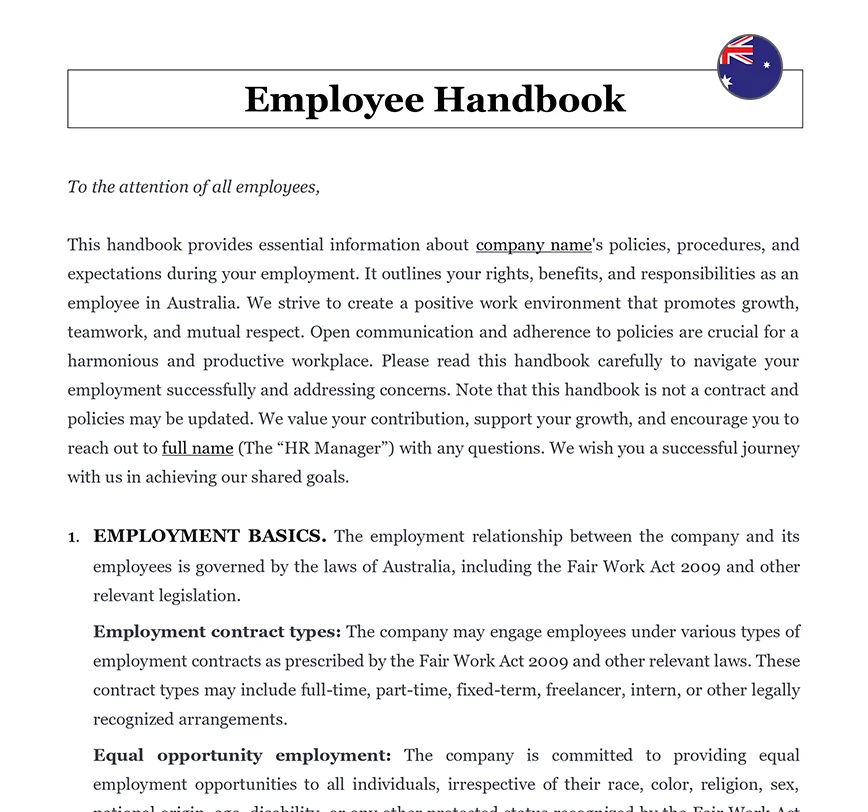Ready to use legal template
Drafted by experienced lawyers
Compliant with Australian law
Ready to use legal template
Drafted by lawyers
Compliant with Australian law
Learn more about Employee Handbook in Australia
An Employee Handbook is an essential document that outlines a company’s policies, procedures, workplace expectations, and employee rights. It serves as a guide for both employers and employees, helping to ensure clarity, consistency, and compliance with Australia’s Fair Work laws and workplace regulations. The handbook typically covers areas such as code of conduct, leave entitlements, health and safety, anti-discrimination policies, and grievance procedures. For businesses operating in Australia, having a well-prepared employee handbook can reduce legal risks, foster a positive work environment, and ensure that all staff understand their roles and responsibilities. Download our Employee Handbook available in an easy to edit Word format and drafted by expert to be used in Australia.
Table of contents
-
-
What is an Employee Handbook in Australia?
-
Why use an Employee Handbook?
-
What should an Employee Handbook include in Australia?
-
How does it address employee rights and benefits in Australia?
-
How does it address performance evaluation?
-
What if I don’t have an Employee Handbook in Australia?
-
How does it reinforce the employment contract in Australia?
-
What is an Employee Handbook in Australia?
An Employee Handbook in Australia is a comprehensive document provided by an employer to their employees. This handbook serves as a central reference that outlines the company’s policies, procedures, expectations, and standards. It typically covers a broad range of topics, including the company’s mission and values, workplace conduct, health and safety regulations, and employee benefits. The Employee Handbook is an essential tool for communicating the organizational culture and operational guidelines, ensuring that all employees are aware of their rights and responsibilities.
In the Australian context, the Employee Handbook plays a critical role in aligning the practices of the organization with the legal framework set by the Fair Work Act 2009 and other relevant legislation. It is designed to be a living document that can be updated as laws change or as the company evolves, providing a consistent and accessible resource for both new hires and long-standing employees. By having an Employee Handbook, employers can standardize their practices and provide clarity, reducing misunderstandings and potential disputes.
Why use an Employee Handbook?
Using an Employee Handbook in Australia offers numerous benefits to both employers and employees. For employers, it serves as a tool to clearly communicate policies and expectations, helping to establish a consistent approach to managing the workforce. This consistency is crucial for maintaining fairness and equity in the workplace. The handbook also helps in legal compliance, as it documents the company’s adherence to employment laws and regulations, which can protect the employer in case of disputes or legal challenges.
For employees, the handbook provides a clear understanding of what is expected of them and what they can expect from the company. It outlines the company’s policies on issues such as attendance, dress code, workplace behavior, and grievance procedures. This transparency helps to create a more organized and harmonious work environment. Furthermore, the handbook can serve as a valuable reference point for employees to understand their rights and benefits, such as leave entitlements, salary reviews, and career development opportunities.
Overall, an Employee Handbook is an essential management tool that enhances communication, ensures compliance, and fosters a positive organizational culture. By clearly articulating policies and procedures, it helps to prevent conflicts and misunderstandings, thereby contributing to a more efficient and effective workplace.
What should an Employee Handbook include in Australia?
An Employee Handbook in Australia should be comprehensive and cover a wide range of topics to ensure that all aspects of employment are addressed. Key elements that should be included are:
1. Company Overview:
This section should include the company’s history, mission, vision, and values. It provides context for employees, helping them understand the broader purpose and goals of the organization.
2. Employment Policies:
Clear policies regarding recruitment, equal opportunity, non-discrimination, and anti-harassment should be included. This ensures that the company’s commitment to a fair and inclusive workplace is clearly communicated.
3. Code of Conduct:
Guidelines on acceptable behavior, professional conduct, and disciplinary procedures. This helps to set expectations for workplace behavior and outlines the consequences of policy violations.
4. Health and Safety:
Policies related to workplace health and safety, including procedures for reporting hazards and incidents. This is crucial for compliance with the Work Health and Safety Act 2011.
5. Employee Benefits and Compensation:
Information on salary, wage reviews, bonuses, and other benefits such as health insurance, retirement plans, and leave entitlements.
6. Leave Policies
Details on various types of leave, including annual leave, sick leave, parental leave, and any other statutory or company-specific leave policies.
7. Performance Evaluation:
Procedures for performance reviews, feedback mechanisms, and career development opportunities. This helps in setting clear performance expectations and provides a framework for employee development.
8. Grievance and Dispute Resolution:
Procedures for addressing workplace grievances and resolving disputes. This section should outline the steps employees can take if they have a complaint or concern.
9. IT and Data Security:
Policies on the use of company IT resources, data protection, and confidentiality. This ensures that employees understand their responsibilities in safeguarding company information.
10. Termination Procedures:
Guidelines on resignation, redundancy, and dismissal, including notice periods and final entitlements.
By including these elements, an Employee Handbook provides a comprehensive guide to the employment relationship, ensuring that both employer and employee are aware of their rights and obligations.
How does it address employee rights and benefits in Australia?
An Employee Handbook in Australia plays a crucial role in outlining employee rights and benefits, ensuring that employees are well-informed about what they are entitled to and what is expected of them. It typically includes detailed information on various entitlements mandated by law, such as minimum wages, leave entitlements, and working hours, as specified under the Fair Work Act 2009.
For example, the handbook will detail the types of leave available to employees, including annual leave, sick leave, and parental leave, along with the procedures for applying for leave and the conditions under which leave can be taken. This ensures that employees are aware of their rights to take time off work and the processes involved in doing so.
The handbook also addresses employee benefits such as health insurance, retirement plans, and other perks that the company may offer. By clearly outlining these benefits, the handbook ensures transparency and helps employees understand the full range of compensation beyond their basic salary. Additionally, it often includes information on performance bonuses, salary reviews, and opportunities for career advancement, providing employees with a clear understanding of how their contributions are recognized and rewarded.
Furthermore, the Employee Handbook sets out the company’s commitment to a fair and inclusive workplace, with policies on equal opportunity, non-discrimination, and anti-harassment. These policies help protect employee rights and promote a positive work environment where all employees are treated with respect and dignity.
How does it address performance evaluation?
Performance evaluation is a critical aspect of employee management, and an Employee Handbook in Australia provides a structured approach to this process. The handbook typically outlines the performance evaluation process, including the frequency of evaluations, the criteria used to assess performance, and the methods of providing feedback.
The performance evaluation section of the handbook should detail the objectives of performance reviews, such as identifying strengths and areas for improvement, setting goals, and providing opportunities for professional development. It may also include information on the different types of performance evaluations, such as annual reviews, probationary reviews, and ongoing performance discussions.
Clear guidelines on the evaluation process help ensure that performance reviews are conducted fairly and consistently. This includes specifying who is responsible for conducting evaluations, how feedback will be communicated, and the steps involved in setting performance goals and development plans. By providing a transparent and structured approach to performance evaluation, the handbook helps employees understand what is expected of them and how their performance will be assessed.
Additionally, the handbook may include information on how performance evaluations are linked to other aspects of employment, such as promotions, salary reviews, and career development opportunities. This helps employees see the connection between their performance and their career progression within the company.
Additionally, it may provide information on the circumstances under which employment termination may occur, including the process for issuing an Employment Termination Letter and any applicable notice periods.
By including these details in the handbook, both employees and employers have a clear understanding of the expectations and processes related to performance evaluation, warnings, and termination, promoting fairness and consistency in employment decisions.
What if I don’t have an Employee Handbook in Australia?
Without an Employee Handbook, employers risk inconsistencies in policy enforcement, misunderstandings among employees, and potential legal liabilities. Lack of clear guidelines can lead to confusion regarding company expectations, rights, and responsibilities, as well as increased risks of disputes and grievances.
How does it reinforce the employment contract in Australia?
An Employee Handbook reinforces the employment contract in Australia by:
| ➤ Providing detailed information about the terms and conditions of employment, including policies and procedures that supplement the contract. |
| ➤ Clarifying rights, obligations, and expectations for both parties, thereby reducing ambiguity and misunderstandings. |
| ➤ Serving as a reference document that employees and employers can consult to resolve disputes or conflicts related to the employment relationship. |
| ➤ Demonstrating the employer's commitment to fairness, transparency, and compliance with legal requirements, which can enhance employee morale and loyalty. |
| ➤Moreover, the handbook may include information on disciplinary procedures, reinforcing the consequences of violating company policies. |




